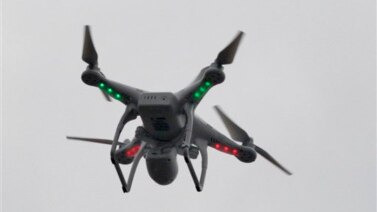Amazon.com has received patent rights to send its products to customers by unmanned drone aircraft. The company is the largest U.S.-based online seller of products. It delivers those products to customers electronically, by mail and by other delivery services.
Now, the company has received a patent for its planned drone delivery system. A patent is “an official document that gives a person or company the right to be the only one that makes or sells a product for a certain period of time.”
In March, federal officials gave Amazon permission to test its drone delivery plan. But even with a patent and the ability of drones to make deliveries, it does not appear the company will put its new delivery system in place any time soon.
The U.S. Patent Office published the document. It describes Amazon’s plans to use the Global Positioning System, or GPS, to deliver products to homes and to wherever people are.
The drone will use a customer’s mobile device -- usually a smartphone -- to avoid hitting people or buildings and to identify a safe area to land. The company wants to deliver products within 30 minutes of people ordering them on its website.
However, the Federal Aviation Administration, or FAA, is worried about security. Although it gave Amazon permission to test the system, the agency said the operators must be able to see the unmanned planes. That greatly limits the delivery area.
Loretta Alkalay is a professor at the Vaughn College of Aeronautics and Technology in New York and a former attorney at the FAA. She told VOA on Skype that Amazon is trying to find a way to show the FAA that its drone technology is safe.
“I think that they’re, they’re going to have to work on those in parallel with advancing the new technology. So I don’t, I don’t see the security problems as being something that should stop the technology.”
Amazon is not yet offering drone delivery. But Professor Alkalay says it will not be long before it does.
“I do think that in, in the reasonably foreseeable future they’re going to start doing deliveries. We already see deliveries being done in disaster areas, in remote areas. I think there’s a huge demand for that type of delivery.”
Professor Alkalay says there are concerns that the drones will crash into objects or people, or that the products and drones will be stolen or intentionally damaged. But she says that is because many people believe the drones would only deliver the products to the front door of a house.
“If you think of drone delivery perhaps to your rooftop, then you would have an opportunity to separate the pedestrian and the vehicular traffic, and at the same time separate it from air traffic.”
Professor Alkalay notes that American homes are not currently able to receive deliveries on their roof tops. However, it is possible that homes will one day have special areas on their roofs designed to receive product deliveries.
I’m Christopher Jones-Cruise.
VOA Science Correspondent George Putic reported this story from Washington. Christopher Jones-Cruise adapted it into VOA Learning English. Mario Ritter was the editor.
Words in This Story
Global Positioning System (GPS) – n. a radio system that uses signals from satellites to tell you where you are and to give you directions to other places
parallel with – idiom. at the same time as another, different activity
foreseeable – adj. seeing or becoming aware of (something that has not yet happened)
remote – adj. far away from other people, houses or cities
pedestrian – adj. relating to or designed for people who are walking
vehicular – adj. of, relating to or designed for vehicles
Are there companies in your country that are planning to deliver products using drones? Will officials in your country permit this delivery method? We want to hear from you. Write to us in the comments section.

